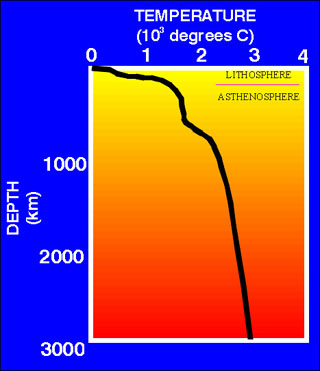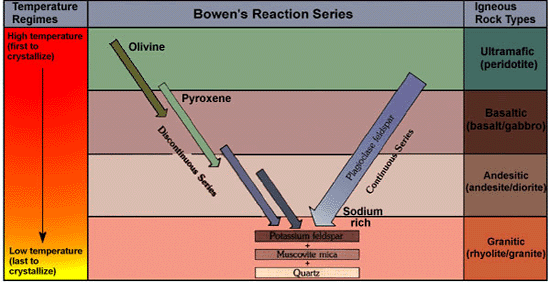Igneous Rocks
 |
| Temperature plote showing the Geothermal Gradient |
Igneous rocks are those rocks that have cooled from magma either deep within the Earth or near or on Earth's surface. The temperatures required to melt rock to form magma are enormous and originate from a number of processes. Roughly 20% of Earth's heat is left over from Earth's formation. The remainder of heat is produced through radioactive decay of unstable isotopes trapped within the earth and as a result of increased pressure caused by overlying material. In general Earth's internal temperature increase 30°C for every kilometer in depth, this increase in temperature in known as the geothermal gradient.
As the temperature of rock rises the individual mineral components begin vibrating and the intermolecular bonds holding minerals together begin to stretch. Melting occurs when the intermolecular bonds are no longer strong enough to hold the vibrating minerals together. Since each mineral has a unique set of physical properties, each mineral has a different temperature at which it will melt known as the melting point. The melting point is also identical to the crystallization point, the temperature at which a mineral will begin to crystallize.
Although the melting and crystallization points are determined by the strength of chemical bonds within a mineral, the pressure of the surrounding environment also affects a mineral's melting point. Increased pressure forces individual atoms and molecules closer together and as a result minerals will require even more energy to overcome these forces before they can melt. This means that greater depths a mineral can be heated to temperatures greater than their melting point and still remain solid. If pressure is released the mineral can then begin to melt, this process is called decompression melting. Water can also dramatically change a minerals melting point. If water is incorporated into a mineral crystal it acts as an impurity causing the melting point to decrease allowing the mineral to melt at lower temperatures.
As stated previously igneous rocks form from the crystallization of magma. This occurs as magma cools and the intermolecular bonds that were broken during melting are now able to reform. Just as with melting, individual minerals have specific temperatures at which they will crystallize. Crystallization is the process of turning from a liquid to a solid. Bowen's Reaction Series describes the order in which individual minerals crystallize as a magma cools. Minerals, such as olivine, which crystallize at high temperatures include more metals such as magnesium and iron in their crystal structure. These minerals are classified as mafic minerals and tend to be darker in color.
 |
| Bowen's reaction series. Diagram shows relative crystalization temperatures of rock forming minerals. |
As mafic minerals form their increased density causes them to sink out of the melt. This means that as more and more mafic minerals form the magma becomes depleted in metals. As the magma continues to cool minerals that form at lower temperatures do not contain as many metals and instead contain considerably more silica. These minerals are classified as felsic minerals and tend to be lighter in color. This process of continuous crystal formation from a magma is called fractional crystallization and it causes a magmas composition to changes over time as it slowly cools.
The depth at which a magma cools will have a number of effects on the resulting rock. If magma cools deep within the Earth, or intrusively, the surrounding material will insulate the magma, much like a comforter insulates a person on a bed. This will cause the magma to cool at a much slower rate and allow individual mineral crystals to grow larger and larger. If, on the other hand, a magma cools on or nearer to the surface, or extrusively, there will be less insulating material and therefore the magma will cool more rapidly. This will result in smaller mineral crystals.
The result of either extrusive or intrusive cooling is evident in the final texture of the igneous rock. The texture of an igneous rock is a measure of crystal size within the rock. Igneous textures are described by a number of terms. The phaneritic texture describes coarse grains or rocks that contain mostly large crystals. A rock with an aphanitic texture has a fine grain; it contains mostly small crystals. Observationally, a rock that exhibits a phaneritic texture would have visible crystals, as seen below. The porphorytic texture describes a rock that exhibits both phaneritic and aphanitic textures.
